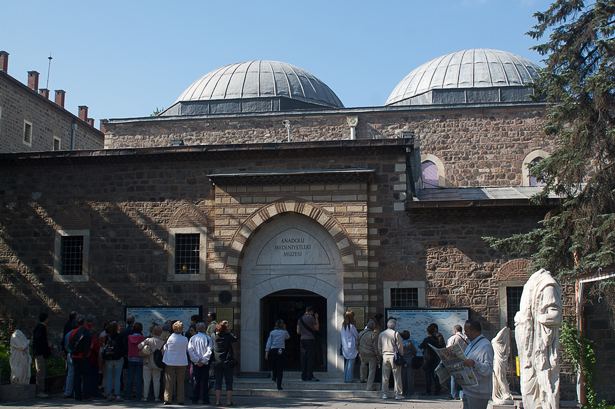Museum of Anatolian Civilizations
The Ankara Anatolian Civilizations Museum, which was awarded the “Museum of the Year in Europe” award in 1997 and was closed in 2010 due to restoration and exhibition – arrangements, is among the best collections in the world with its magnificent collections. The ceremony attended by the Minister Mr. Ömer ÇELİK was reopened.
As the founder of our Republic, Mustafa Kemal Ataturk, started to set up a “Eti Museum” in Ankara, as well as sending Hittite artifacts from other illusions of Turkey to Ankara, a museum building with large spaces was deemed necessary; A comprehensive restoration work was started between 1938 and 1968 in Mahmut Paşa Bedesten and Kurşunlu Han, which dates back to the 15th century and was used as a museum by the proposal of the Cultural Director of the period Hamit Zübeyr Kosay. The restoration of a large part of the domed space in the middle part of the bedesten was completed in 1940 and the works were started to be installed by a delegation headed by the German archaeologist H. G. Guterbock, while the restoration of the buildings was continued in 1943 and the middle part was partially opened. In 1948, the Museum Administration moved to four rooms where the Kurşunlu Han was repaired. Today Kurşunlu Han, which is used as an administrative building, has research rooms, library, conference hall, laboratory and workshops and Mahmut Paşa Bedesten is used as an exhibition hall.
In the museum, a new arrangement was made with the understanding of today’s museology while at the same time the maintenance and repair of the monumental structures were also carried out. Restoration projects were prepared in 2010 and the tender was made on 31.07.2012. Bedesten dome was renovated with lead coating, Arastan wooden roof construction was repaired and the shop system along the axle was rebuilt on the basis of 5 shops in the eastern part. Within the scope of restoration and new exhibition projects carried out between 2012 and 2014 in accordance with the original architecture; The works from the Palaeolithic period to the end of the Eastern Roman period (BC 1.000.000 – M.S.15.yy) were exhibited chronologically.
In the museum; All the windows and information panels of the sections from the Paleolithic Age to the Urartu Period were renewed. Touchscreen digital displays tell you which centers the works exhibited in the museum come from visitors. Kaltepe works and Midas / Gordios’ tomb were used for virtual tour. In the LED screens, the documentary tells the story of the Bedesten transforming into the museum and the days it has been through the day, and the life story of the Paleolithic Anatolian people is described as an animated film. In the Early Bronze Age section, a miner’s workshop was enacted. In the Neolithic Age section, two T-shaped Gobelite plantings were replicated. In the Phrygian section, the frontal front of the Arazastis Monument in the Frig Valley and the marketed Phrygian house were featured.
The Museum of Anatolian Civilizations is waiting for a visit with its new collection and collection.
MORE













